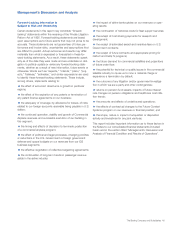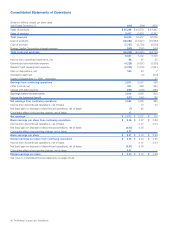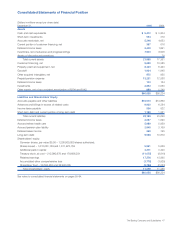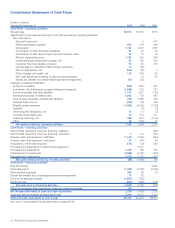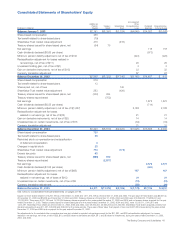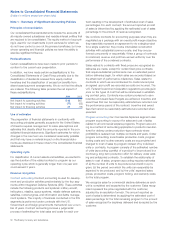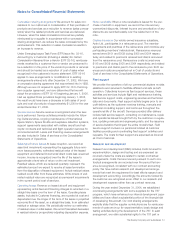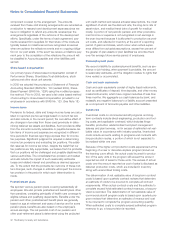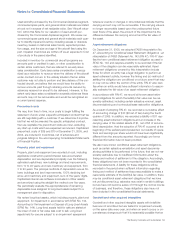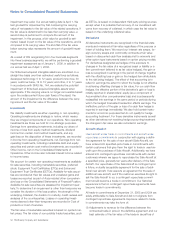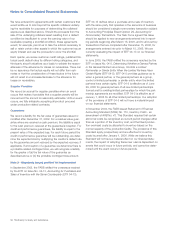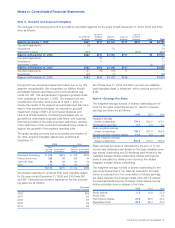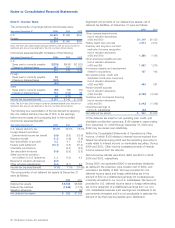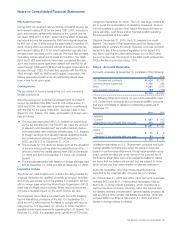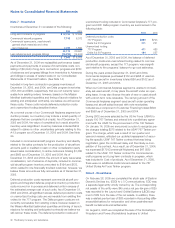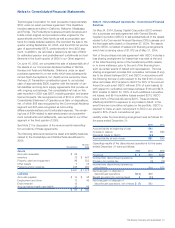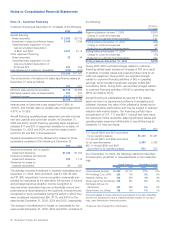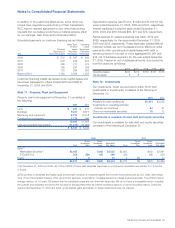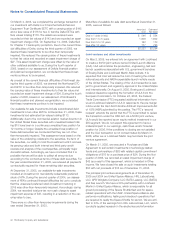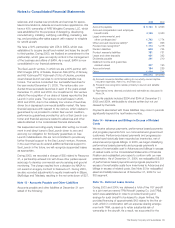Boeing 2005 Annual Report Download - page 57
Download and view the complete annual report
Please find page 57 of the 2005 Boeing annual report below. You can navigate through the pages in the report by either clicking on the pages listed below, or by using the keyword search tool below to find specific information within the annual report.Notes to Consolidated Financial Statements
the date of such agreement, which will be recognized in
future periods upon delivery of the Sale Aircraft and/or
(2) Charges to cost of products for adverse changes in the fair
value of trade-in aircraft that occur subsequent to signing of
a definitive agreement for Sale Aircraft but prior to the pur-
chase of the used trade-in aircraft. Estimates based on cur-
rent aircraft values are included in Accounts payable and
other liabilities.
The fair value of trade-in aircraft is determined using aircraft
specific data such as, model, age and condition, market condi-
tions for specific aircraft and similar models, and multiple valua-
tion sources. This process uses our assessment of the market
for each trade-in aircraft, which in most instances begins years
before the return of the aircraft. There are several possible mar-
kets in which we continually pursue opportunities to place used
aircraft. These markets include, but are not limited to, the
resale market, which could potentially include the cost of long-
term storage; the leasing market, with the potential for refur-
bishment costs to meet the leasing customer’s requirements;
or the scrap market. Trade-in aircraft valuation varies signifi-
cantly depending on which market we determine is most likely
for each aircraft. On a quarterly basis, we update our valuation
analysis based on the actual activities associated with placing
each aircraft into a market. This quarterly valuation process
yields results that are typically lower than residual value esti-
mates by independent sources and tends to more accurately
reflect results upon the actual placement of the aircraft.
Used aircraft acquired by the Commercial Airplanes segment
are included in Inventories at the lower of cost or market as it is
our intent to sell these assets. To mitigate costs and enhance
marketability, aircraft may be placed on operating lease. While
on operating lease, the assets are included in Customer financ-
ing, however, the valuation continues to be based on the lower
of cost or market. The lower of cost or market assessment is
performed quarterly using the process described above.
Asset valuation for assets under operating lease, assets held
for sale or re-lease and collateral underlying receivables
Included in Customer financing are operating lease equipment,
notes receivables and sales-type/financing leases. Sales-
type/financing leases are treated as receivables, and
allowances are established in accordance with SFAS No. 13,
Accounting for Leases and SFAS No. 118, Accounting by
Creditors for Impairment of a Loan, as amended.
We assess the fair value of the assets we own, including equip-
ment under operating leases, assets held for sale or re-lease
and collateral underlying receivables, to determine if their fair
values are less than the related assets’ carrying values.
Differences between carrying values and fair values of finance
leases and notes and other receivables, as determined by col-
lateral value, are considered in determining the allowance for
losses on receivables.
We use a median calculated from published collateral values
from multiple external equipment appraisers based on the type
and age of the aircraft to determine the fair value of aircraft.
Under certain circumstances, we apply judgment based on the
attributes of the specific aircraft or equipment, usually when the
features or use of the aircraft vary significantly from the more
generic aircraft attributes covered by outside publications.
Impairment review for assets under operating leases and held
for sale or re-lease We evaluate assets under operating lease or
held for re-lease for impairment when the expected undis-
counted cash flow over the remaining useful life is less than the
carrying value. We use various assumptions when determining
the expected undiscounted cash flow. These assumptions
include expected future lease rates, lease terms, end of eco-
nomic life value of the aircraft or equipment, periods in which
the asset may be held in preparation for a follow-on lease,
maintenance costs, remarketing costs, the remaining economic
life of the asset and estimated proceeds from future asset
sales. We state assets held for sale at the lower of carrying
value or fair value less costs to sell.
When we determine that impairment is indicated for an asset,
the amount of asset impairment expense recorded is the
excess of the carrying value over the fair value of the asset.
Allowance for losses on receivables We record the potential
impairment of receivables in our portfolio in a valuation
account, the balance of which is an accounting estimate of
probable but unconfirmed losses in the receivables portfolio.
The allowance for losses on receivables relates to two compo-
nents of receivables: (a) specifically identified receivables that
are evaluated individually for impairment and (b) all other receiv-
ables.
We determine a receivable is impaired when, based on current
information and events, it is probable that we will be unable to
collect amounts due according to the original contractual terms
of the receivable agreement, without regard to any subsequent
restructurings. Factors considered in assessing collectibility
include, but are not limited to, a customer’s extended delin-
quency, requests for restructuring and filings for bankruptcy.
We determine a specific impairment allowance based on the
difference between the carrying value of the receivable and the
estimated fair value of the related collateral.
The general allowance represents our best estimate of losses
existing in the remaining receivables (receivables not subject to
a specific allowance) considering delinquencies, loss experi-
ence, collateral values, guarantees, risk of individual customer
credits, published historical default rates for different rating cat-
egories, results of periodic credit reviews and the general state
of the economy and airline industry.
We review the adequacy of the general allowance by assessing
both the collateral exposure and the applicable cumulative
default rate. Collateral exposure for a particular receivable is the
excess of the carrying value of the receivable over the fair value
of the related collateral. A receivable with an estimated fair
value in excess of the carrying value is considered to have no
collateral exposure. The applicable cumulative default rate is
determined using two components: customer credit ratings
and weighted average remaining contract term. Credit ratings
are determined for each customer in the portfolio. Those rat-
ings are updated based upon public information and informa-
tion obtained directly from our customers.
The Boeing Company and Subsidiaries 55


